Photocatalytic Performance Evaluation of Titanium Dioxide Nanotube-Reinforced Cement Paste
Abstract
1. Introduction
2. Experimental Procedures
2.1. Raw Materials
2.2. Hydrothermal Synthesis of TNT
2.3. BET Analysis
2.4. Preparation of Cement Paste
2.5. X-ray Diffraction
2.6. Thermogravimetric Analysis
2.7. Transmission Electron Microscopy
2.8. Photocatalytic Test by Methylene Blue Degradation
3. Results and Discussion
3.1. Characteristics of the Raw Materials
3.2. Hydration Products
3.3. Photocatalytic Performance
4. Conclusions
Author Contributions
Funding
Conflicts of Interest
References
- Nakata, K.; Fujishima, A. TiO2 photocatalysis: Design and applications. J. Photochem. Photobiol. C 2012, 13, 169–189. [Google Scholar] [CrossRef]
- Schneider, J.; Matsuoka, M.; Takeuchi, M.; Zhang, J.; Horiuchi, Y.; Anpo, M.; Bahnemann, D.W. Understanding TiO2 photocatalysis: Mechanisms and materials. Chem. Rev. 2014, 114, 9919–9986. [Google Scholar] [CrossRef]
- Tang, Y.; Zhang, Y.; Deng, J.; Wei, J.; Le Tam, H.; Chandran, B.K.; Dong, Z.; Chen, Z.; Chen, X. Mechanical force-driven growth of elongated bending TiO2-based nanotubular materials for ultrafast rechargeable lithium ion batteries. Adv. Mater. 2014, 26, 6111–6118. [Google Scholar] [CrossRef] [PubMed]
- Subramanian, V.; Karki, A.; Gnanasekar, K.I.; Eddy, F.P.; Rambabu, B. Nanocrystalline TiO2 (anatase) for Li-ion batteries. J. Power Sources 2006, 159, 186–192. [Google Scholar] [CrossRef]
- Roy, P.; Kim, D.; Lee, K.; Spiecker, E.; Schmuki, P. TiO2 nanotubes and their application in dye-sensitized solar cells. Nanoscale 2010, 2, 45–59. [Google Scholar] [CrossRef] [PubMed]
- Tan, B.; Wu, Y. Dye-Sensitized Solar Cells Based on Anatase TiO2 Nanoparticle/Nanowire Composites. J. Phys. Chem. B 2006, 110, 15932–15938. [Google Scholar] [CrossRef] [PubMed]
- Hashimoto, K.; Irie, H.; Fujishima, A. TiO2 Photocatalysis: A Historical Overview and Future Prospects. Jpn. J. Appl. Phys. 2005, 44, 8269–8285. [Google Scholar] [CrossRef]
- Zhang, J.; Zhou, P.; Liu, J.; Yu, J. New understanding of the difference of photocatalytic activity among anatase, rutile and brookite TiO2. Phys. Chem. Chem. Phys. 2014, 16, 20382–20386. [Google Scholar] [CrossRef]
- Macphee, D.E.; Folli, A. Photocatalytic concretes—The interface between photocatalysis and cement chemistry. Cem. Concr. Res. 2016, 85, 48–54. [Google Scholar] [CrossRef]
- Hamidi, F.; Aslani, F. TiO2-based Photocatalytic Cementitious Composites: Materials, Properties, Influential Parameters, and Assessment Techniques. Nanomaterials 2019, 9, 1444. [Google Scholar] [CrossRef]
- Yang, J.; Wang, G.; Wang, D.; Liu, C.; Zhang, Z. A self-cleaning coating material of TiO2 porous microspheres/cement composite with high-efficient photocatalytic depollution performance. Mater. Lett. 2017, 200, 1–5. [Google Scholar] [CrossRef]
- Yuenyongsuwan, J.; Sinthupinyo, S.; O’Rear, E.A.; Pongprayoon, T. Hydration accelerator and photocatalyst of nanotitanium dioxide synthesized via surfactant-assisted method in cement mortar. Cem. Concr. Compos. 2019, 96, 182–193. [Google Scholar] [CrossRef]
- Chen, J.; Poon, C.-S. Photocatalytic Cementitious Materials: Influence of the Microstructure of Cement Paste on Photocatalytic Pollution Degradation. Environ. Sci. Technol. 2009, 43, 8948–8952. [Google Scholar] [CrossRef] [PubMed]
- Feng, S.; Liu, F.; Fu, X.; Peng, X.; Zhu, J.; Zeng, Q.; Song, J. Photocatalytic performances and durability of TiO2/cement composites prepared by a smear method for organic wastewater degradation. Ceram. Int. 2019, 45, 23061–23069. [Google Scholar] [CrossRef]
- Silvestre, J.; Silvestre, N.; de Brito, J. Review on concrete nanotechnology. Eur. J. Environ. Civ. Eng 2015, 20, 455–485. [Google Scholar] [CrossRef]
- Cao, M.; Ming, X.; He, K.; Li, L.; Shen, S. Effect of Macro-, Micro- and Nano-Calcium Carbonate on Properties of Cementitious Composites—Review. Materials 2019, 12, 781. [Google Scholar] [CrossRef]
- Mendoza Reales, O.A.; Dias Toledo Filho, R. A review on the chemical, mechanical and microstructural characterization of carbon nanotubes-cement based composites. Constr. Build. Mater. 2017, 154, 697–710. [Google Scholar] [CrossRef]
- Chen, J.; Kou, S.-C.; Poon, C.-S. Hydration and properties of nano-TiO2 blended cement composites. Cem. Concr. Compos. 2012, 34, 642–649. [Google Scholar] [CrossRef]
- Li, Z.; Wang, J.; Li, Y.; Yu, X.; Han, B. Investigating size effect of anatase phase nano TiO2 on the property of cement-based composites. Mater. Res. Express 2018, 5, 1591. [Google Scholar] [CrossRef]
- Zhang, R.; Cheng, X.; Hou, P.; Ye, Z. Influences of nano-TiO2 on the properties of cement-based materials: Hydration and drying shrinkage. Constr. Build. Mater. 2015, 81, 35–41. [Google Scholar] [CrossRef]
- Sikora, P.; Abd Elrahman, M.; Stephan, D. The Influence of Nanomaterials on the Thermal Resistance of Cement-Based Composites—A Review. Nanomaterials 2018, 8, 465. [Google Scholar] [CrossRef] [PubMed]
- Yoo, D.-Y.; You, I.; Zi, G.; Lee, S.-J. Effects of carbon nanomaterial type and amount on self-sensing capacity of cement paste. Measurement 2019, 134, 750–761. [Google Scholar] [CrossRef]
- Siad, H.; Lachemi, M.; Sahmaran, M.; Mesbah, H.A.; Hossain, K.A. Advanced engineered cementitious composites with combined self-sensing and self-healing functionalities. Constr. Build. Mater. 2018, 176, 313–322. [Google Scholar] [CrossRef]
- Ruot, B.; Plassais, A.; Olive, F.; Guillot, L.; Bonafous, L. TiO2-containing cement pastes and mortars: Measurements of the photocatalytic efficiency using a rhodamine B-based colourimetric test. Sol. Energy 2009, 83, 1794–1801. [Google Scholar] [CrossRef]
- Jimenez-Relinque, E.; Llorente, I.; Castellote, M. TiO2 cement-based materials: Understanding optical properties and electronic band structure of complex matrices. Catal. Today 2017, 287, 203–209. [Google Scholar] [CrossRef]
- Folli, A.; Pade, C.; Hansen, T.B.; De Marco, T.; Macphee, D.E. TiO2 photocatalysis in cementitious systems: Insights into self-cleaning and depollution chemistry. Cem. Concr. Res. 2012, 42, 539–548. [Google Scholar] [CrossRef]
- Seo, D.; Yun, T.S. NOx removal rate of photocatalytic cementitious materials with TiO2 in wet condition. Build. Environ. 2017, 112, 233–240. [Google Scholar] [CrossRef]
- Zhang, Z.; Wang, C.-C.; Zakaria, R.; Ying, J.Y. Role of Particle Size in Nanocrystalline TiO2-Based Photocatalysts. J. Phys. Chem. B 1998, 102, 10871–10878. [Google Scholar] [CrossRef]
- Park, J.; Suh, H.; Woo, S.M.; Jeong, K.; Seok, S.; Bae, S. Assessment of neutron shielding performance of nano-TiO2-incorporated cement paste by Monte Carlo simulation. Prog. Nucl. Energy 2019, 117, 103043. [Google Scholar] [CrossRef]
- Kasuga, T.; Hiramatsu, M.; Hoson, A.; Sekino, T.; Niihara, K. Formation of Titanium Oxide Nanotube. Langmuir 1998, 14, 3160–3163. [Google Scholar] [CrossRef]
- Smith, Y.R.; Kar, A.; Subramanian, V. Investigation of Physicochemical Parameters That Influence Photocatalytic Degradation of Methyl Orange over TiO2 Nanotubes. Ind. Eng. Chem. Res. 2009, 48, 10268–10276. [Google Scholar] [CrossRef]
- Zhou, X.; Liu, N.; Schmuki, P. Photocatalysis with TiO2 Nanotubes: “Colorful” Reactivity and Designing Site-Specific Photocatalytic Centers into TiO2 Nanotubes. ACS Catal. 2017, 7, 3210–3235. [Google Scholar] [CrossRef]
- Ananthakumar, S.; Ramkumar, J.; Babu, S.M. Semiconductor nanoparticles sensitized TiO2 nanotubes for high efficiency solar cell devices. Renew. Sustain Energy Rev. 2016, 57, 1307–1321. [Google Scholar] [CrossRef]
- Lv, H.; Wang, Y.; Pan, L.; Zhang, L.; Zhang, H.; Shang, L.; Qu, H.; Li, N.; Zhao, J.; Li, Y. Patterned polyaniline encapsulated in titania nanotubes for electrochromism. Phys. Chem. Chem. Phys. 2018, 20, 5818–5826. [Google Scholar] [CrossRef] [PubMed]
- Jee, H.; Park, J.; Zalnezhad, E.; Jeong, K.; Woo, S.M.; Seok, S.; Bae, S. Characterization of Titanium Nanotube Reinforced Cementitious Composites: Mechanical Properties, Microstructure, and Hydration. Materials 2019, 12, 1617. [Google Scholar] [CrossRef] [PubMed]
- Kasuga, T.; Hiramatsu, M.; Hoson, A.; Sekino, T.; Niihara, K. Titania Nanotubes Prepared by Chemical Processing. Adv. Mater. 1999, 11, 1307–1311. [Google Scholar] [CrossRef]
- Liu, N.; Chen, X.; Zhang, J.; Schwank, J.W. A review on TiO2-based nanotubes synthesized via hydrothermal method: Formation mechanism, structure modification, and photocatalytic applications. Catal. Today 2014, 225, 34–51. [Google Scholar] [CrossRef]
- Scrivener, K.; Snellings, R.; Lothenbach, B. A Practical Guide to Microstructural Analysis of Cementitious Materials; CRC Press: Boca Raton, FL, USA, 2018. [Google Scholar]
- Wei, X.; Zhu, G.; Fang, J.; Chen, J. Synthesis, Characterization, and Photocatalysis of Well-Dispersible Phase-Pure Anatase TiO2 Nanoparticles. Int. J. Photoenergy 2013, 2013, 726872. [Google Scholar] [CrossRef]
- Li, D.; Song, H.; Meng, X.; Shen, T.; Sun, J.; Han, W.; Wang, X. Effects of Particle Size on the Structure and Photocatalytic Performance by Alkali-Treated TiO2. Nanomaterials 2020, 10, 546. [Google Scholar] [CrossRef]
- Lopez Zavala, M.A.; Lozano Morales, S.A.; Avila-Santos, M. Synthesis of stable TiO2 nanotubes: Effect of hydrothermal treatment, acid washing and annealing temperature. Heliyon 2017, 3, e00456. [Google Scholar] [CrossRef]
- Wang, D.; Zhou, F.; Liu, Y.; Liu, W. Synthesis and characterization of anatase TiO2 nanotubes with uniform diameter from titanium powder. Mater. Lett. 2008, 62, 1819–1822. [Google Scholar] [CrossRef]
- Jiang, F.; Zheng, S.; An, L.; Chen, H. Effect of calcination temperature on the adsorption and photocatalytic activity of hydrothermally synthesized TiO2 nanotubes. Appl. Surf. Sci. 2012, 258, 7188–7194. [Google Scholar] [CrossRef]
- Harsha, N.; Ranya, K.R.; Babitha, K.B.; Shukla, S.; Biju, S.; Reddy, M.L.; Warrier, K.G. Hydrothermal processing of hydrogen titanate/anatase-titania nanotubes and their application as strong dye-adsorbents. J. Nanosci. Nanotechnol. 2011, 11, 1175–1187. [Google Scholar] [CrossRef] [PubMed]
- Zhou, C.-H.; Xu, S.; Yang, Y.; Yang, B.-C.; Hu, H.; Quan, Z.-C.; Sebo, B.; Chen, B.-l.; Tai, Q.-D.; Sun, Z.-H.; et al. Titanium dioxide sols synthesized by hydrothermal methods using tetrabutyl titanate as starting material and the application in dye sensitized solar cells. Electrochim. Acta 2011, 56, 4308–4314. [Google Scholar] [CrossRef]
- Chen, J.; Wang, H.; Wei, X.; Zhu, L. Characterization, properties and catalytic application of TiO2 nanotubes prepared by ultrasonic-assisted sol-hydrothermal method. Mater. Res. Bull. 2012, 47, 3747–3752. [Google Scholar] [CrossRef]
- Wang, Y.Q.; Hu, G.Q.; Duan, X.F.; Sun, H.L.; Xue, Q.K. Microstructure and formation mechanism of titanium dioxide nanotubes. Chem. Phys. Lett. 2002, 365, 427–431. [Google Scholar] [CrossRef]
- Snehal, K.; Das, B.B.; Akanksha, M. Early age, hydration, mechanical and microstructure properties of nano-silica blended cementitious composites. Constr. Build. Mater. 2020, 233, 117212. [Google Scholar] [CrossRef]
- Suh, H.; Jee, H.; Kim, J.; Kitagaki, R.; Ohki, S.; Woo, S.; Jeong, K.; Bae, S. Influences of rehydration conditions on the mechanical and atomic structural recovery characteristics of Portland cement paste exposed to elevated temperatures. Constr. Build. Mater. 2020, 235, 117453. [Google Scholar] [CrossRef]
- Lu, Z.; Wang, Q.; Yin, R.; Chen, B.; Li, Z. A novel TiO2/foam cement composite with enhanced photodegradation of methyl blue. Constr. Build. Mater. 2016, 129, 159–162. [Google Scholar] [CrossRef]
- Cerro-Prada, E.; Garcia-Salgado, S.; Quijano, M.A.; Varela, F. Controlled Synthesis and Microstructural Properties of Sol-Gel TiO2 Nanoparticles for Photocatalytic Cement Composites. Nanomaterials 2018, 9, 26. [Google Scholar] [CrossRef]
- Macak, J.M.; Zlamal, M.; Krysa, J.; Schmuki, P. Self-organized TiO2 nanotube layers as highly efficient photocatalysts. Small 2007, 3, 300–304. [Google Scholar] [CrossRef] [PubMed]
- Folli, A.; Jakobsen, U.H.; Guerrini, G.L.; Macphee, D.E. Rhodamine B Discolouration on TiO2 in the Cement Environment: A Look at Fundamental Aspects of the Self-cleaning Effect in Concretes. J. Adv. Oxid. Technol. 2009, 12, 126–133. [Google Scholar] [CrossRef]
- Folli, A.; Pochard, I.; Nonat, A.; Jakobsen, U.H.; Shepherd, A.M.; Macphee, D.E. Engineering Photocatalytic Cements: Understanding TiO2 Surface Chemistry to Control and Modulate Photocatalytic Performances. J. Am. Ceram. Soc. 2010, 93, 3360–3369. [Google Scholar] [CrossRef]
- Feng, S.; Song, J.; Liu, F.; Fu, X.; Guo, H.; Zhu, J.; Zeng, Q.; Peng, X.; Wang, X.; Ouyang, Y.; et al. Photocatalytic properties, mechanical strength and durability of TiO2/cement composites prepared by a spraying method for removal of organic pollutants. Chemosphere 2020, 254, 126813. [Google Scholar] [CrossRef] [PubMed]
- Shen, W.; Zhang, C.; Li, Q.; Zhang, W.; Cao, L.; Ye, J. Preparation of titanium dioxide nano particle modified photocatalytic self-cleaning concrete. J. Clean. Prod. 2015, 87, 762–765. [Google Scholar] [CrossRef]
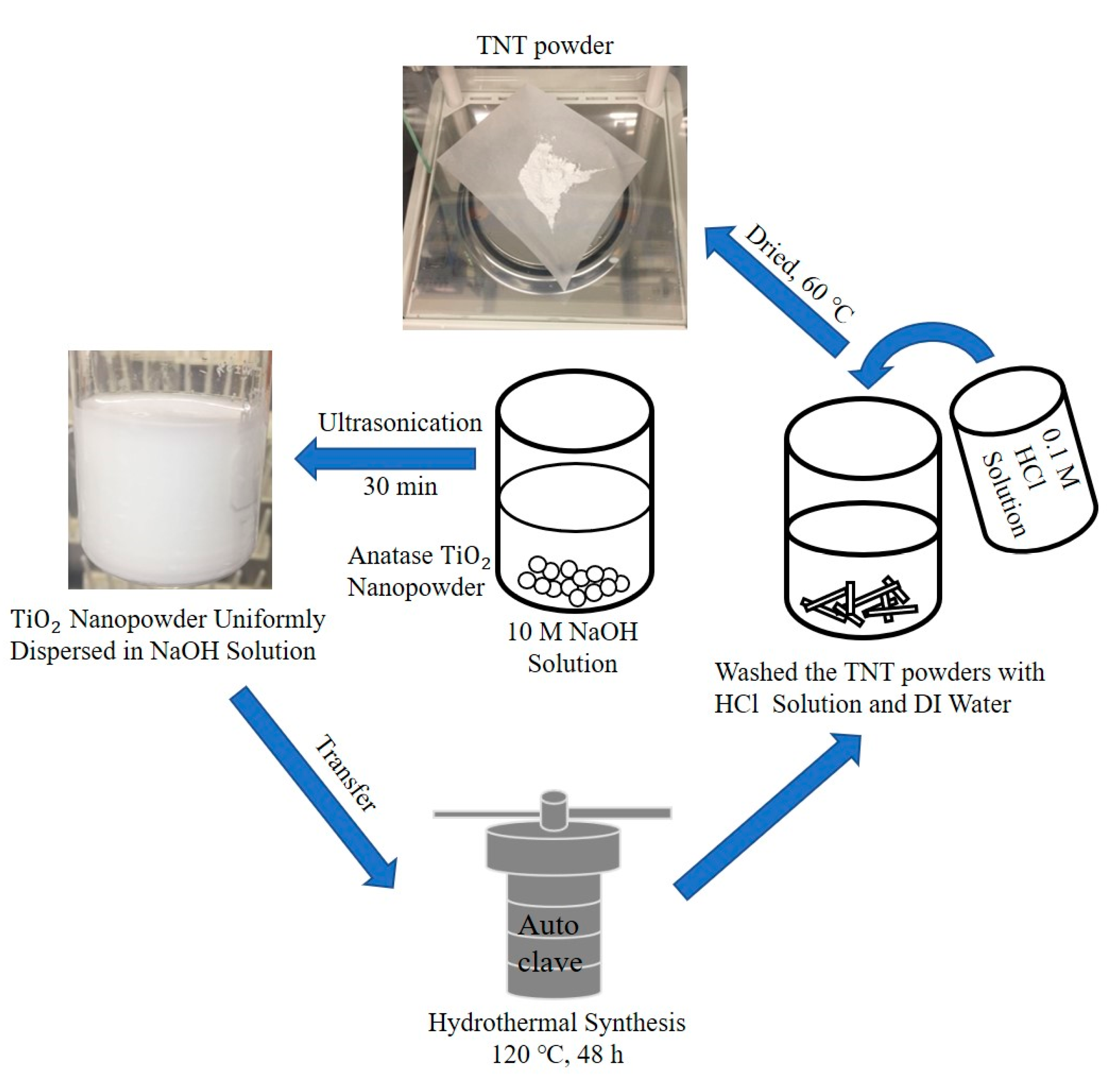
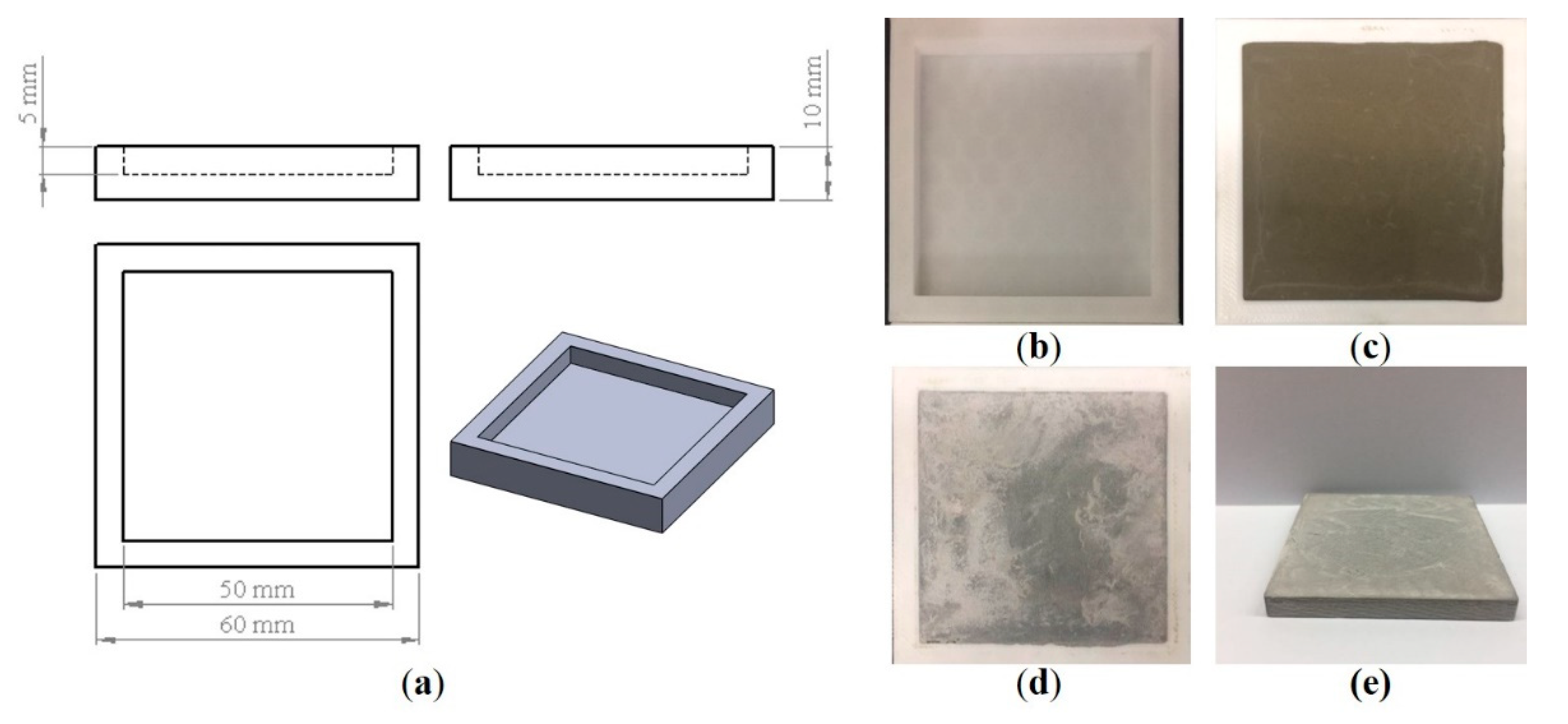
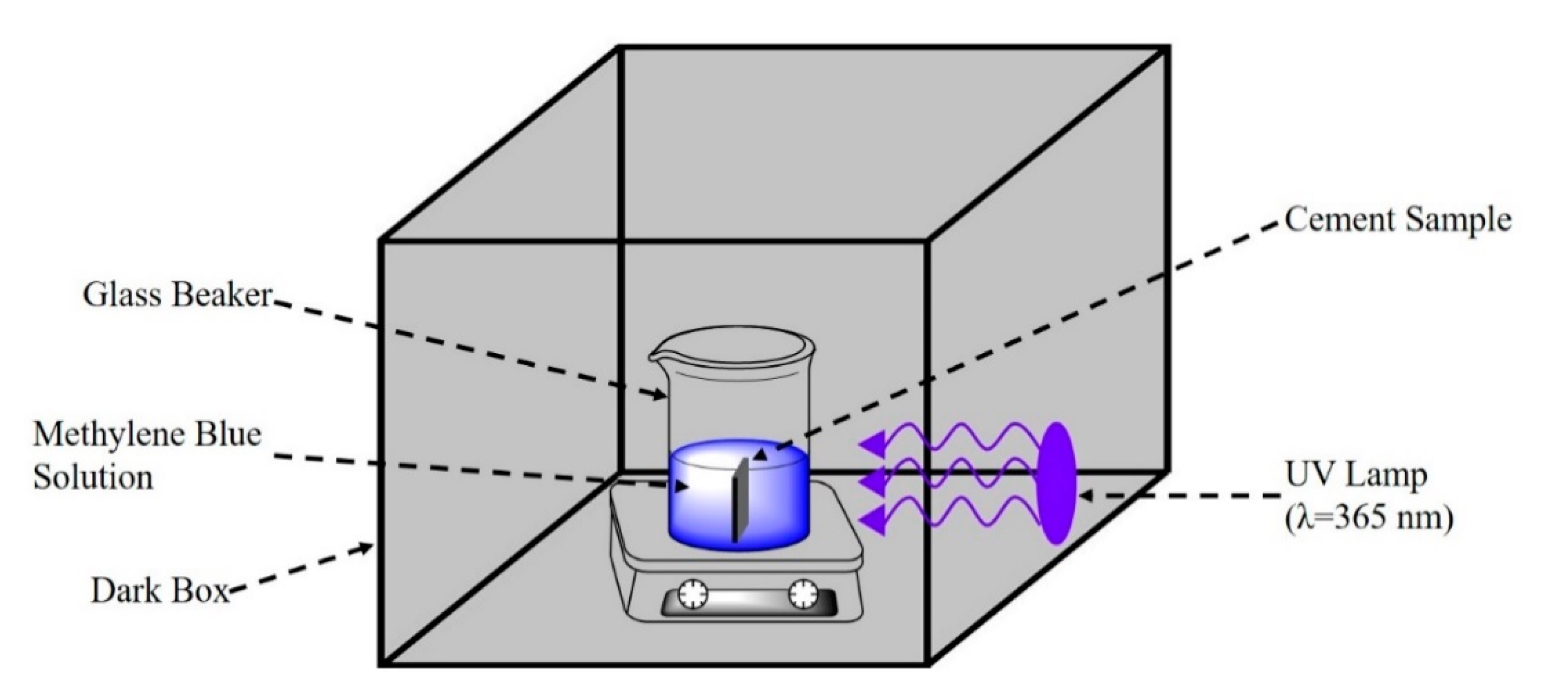
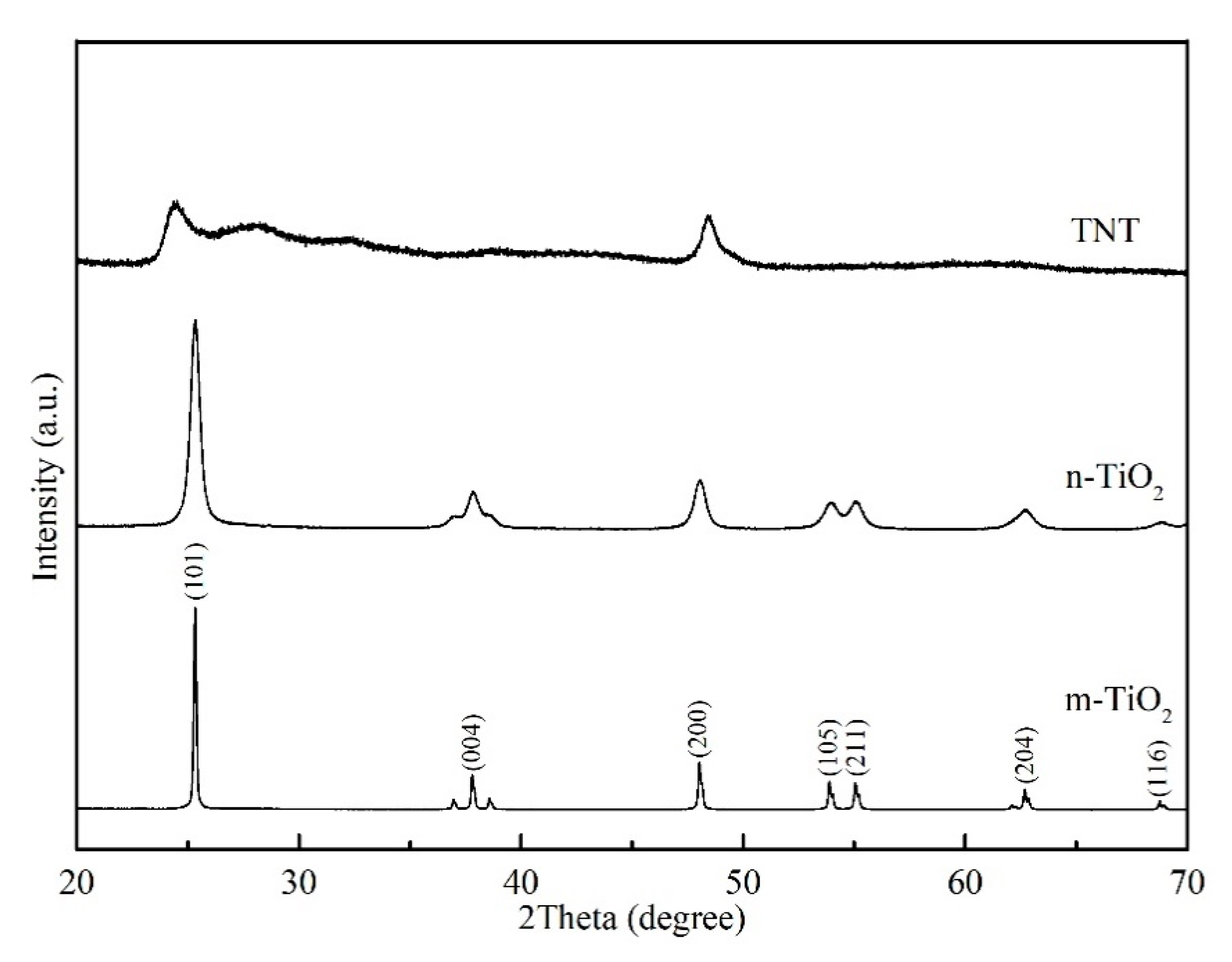
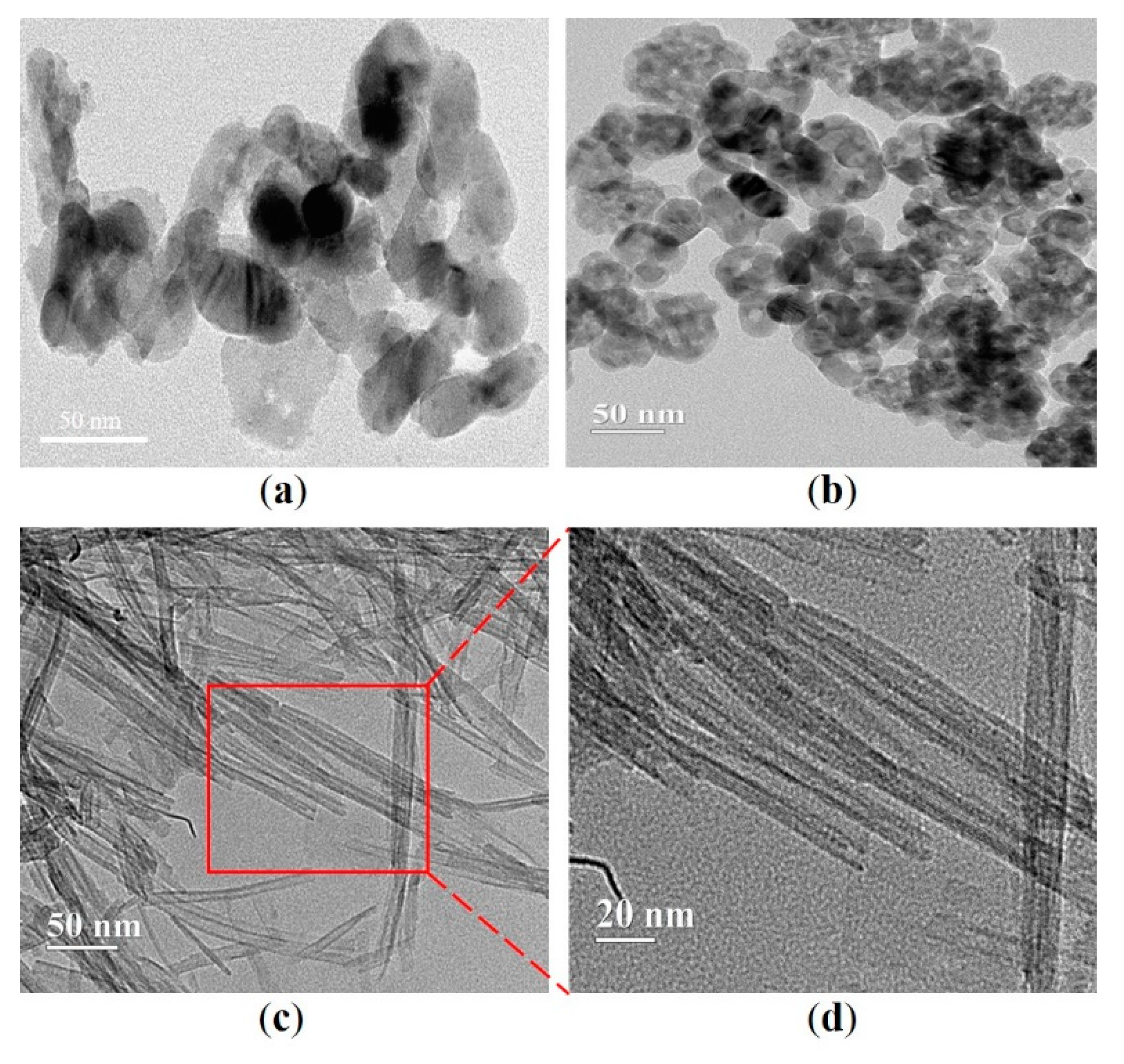
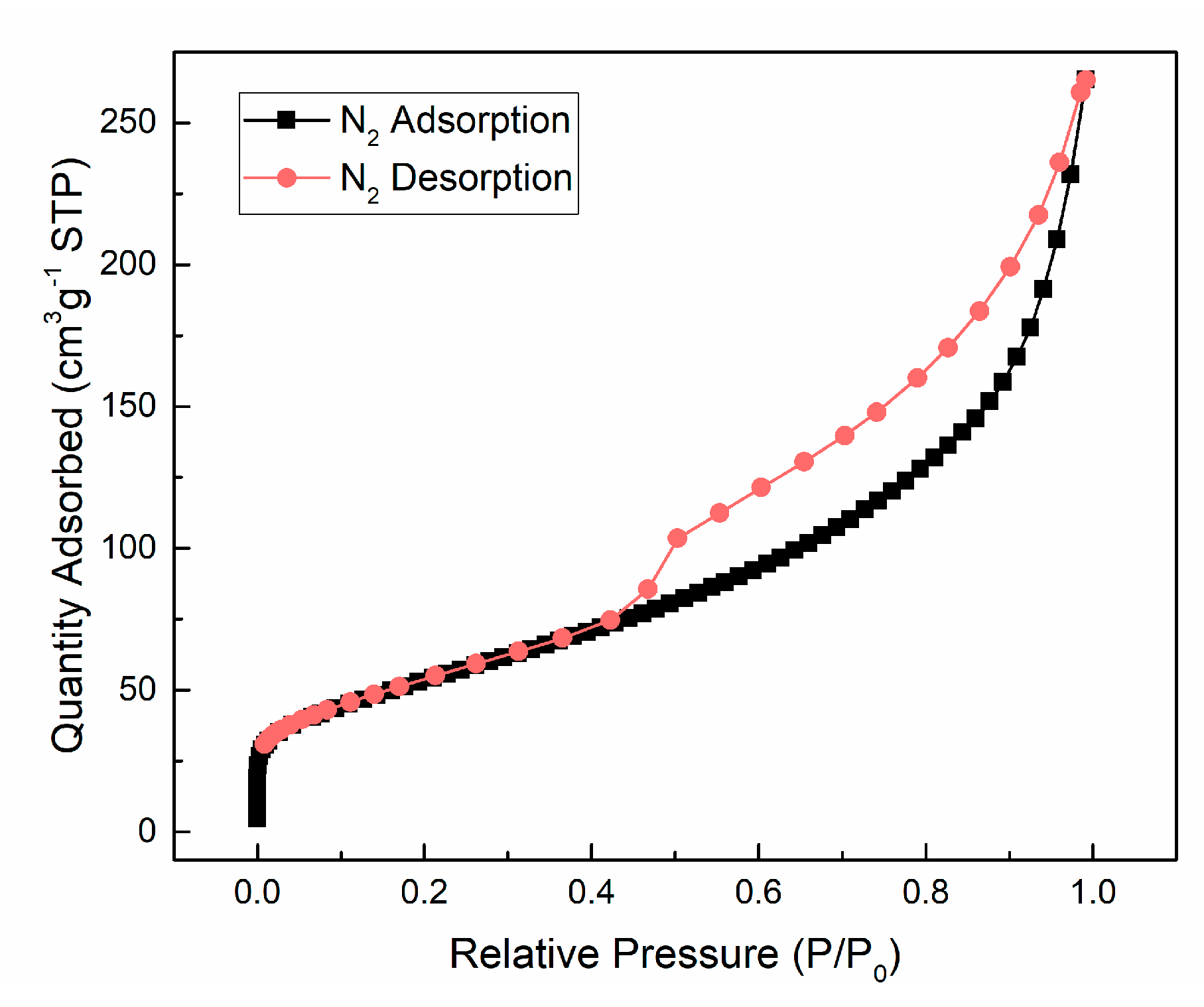

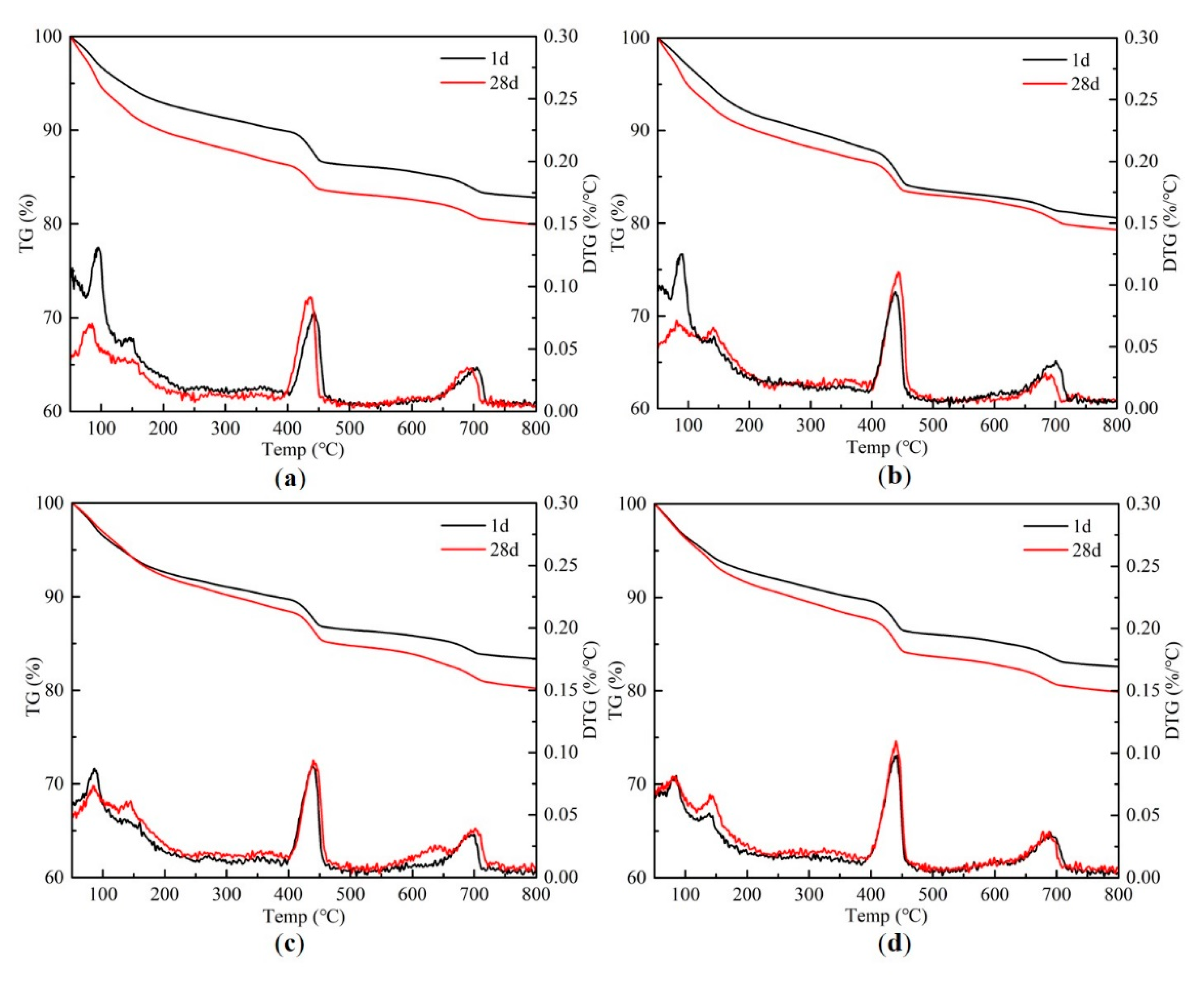
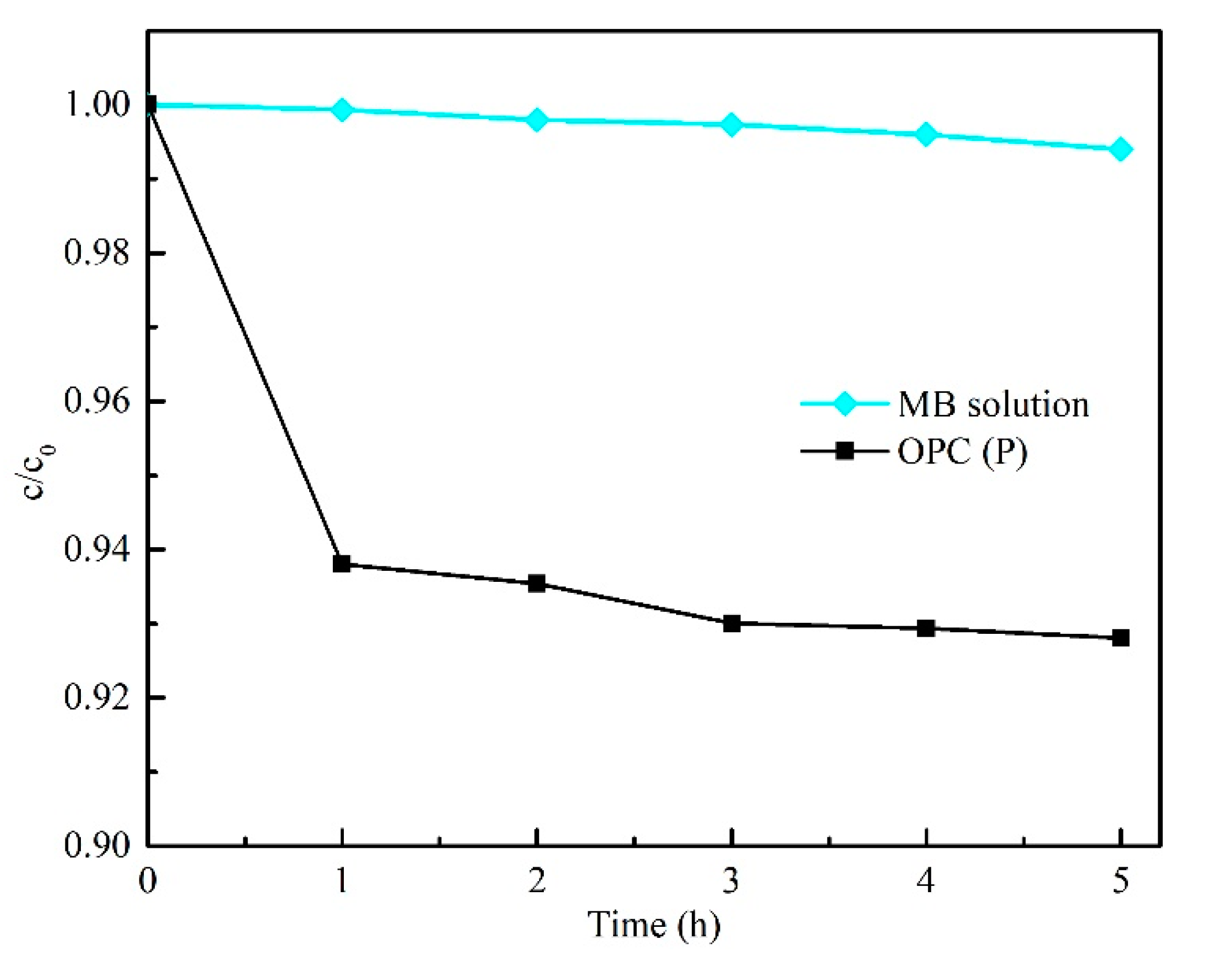
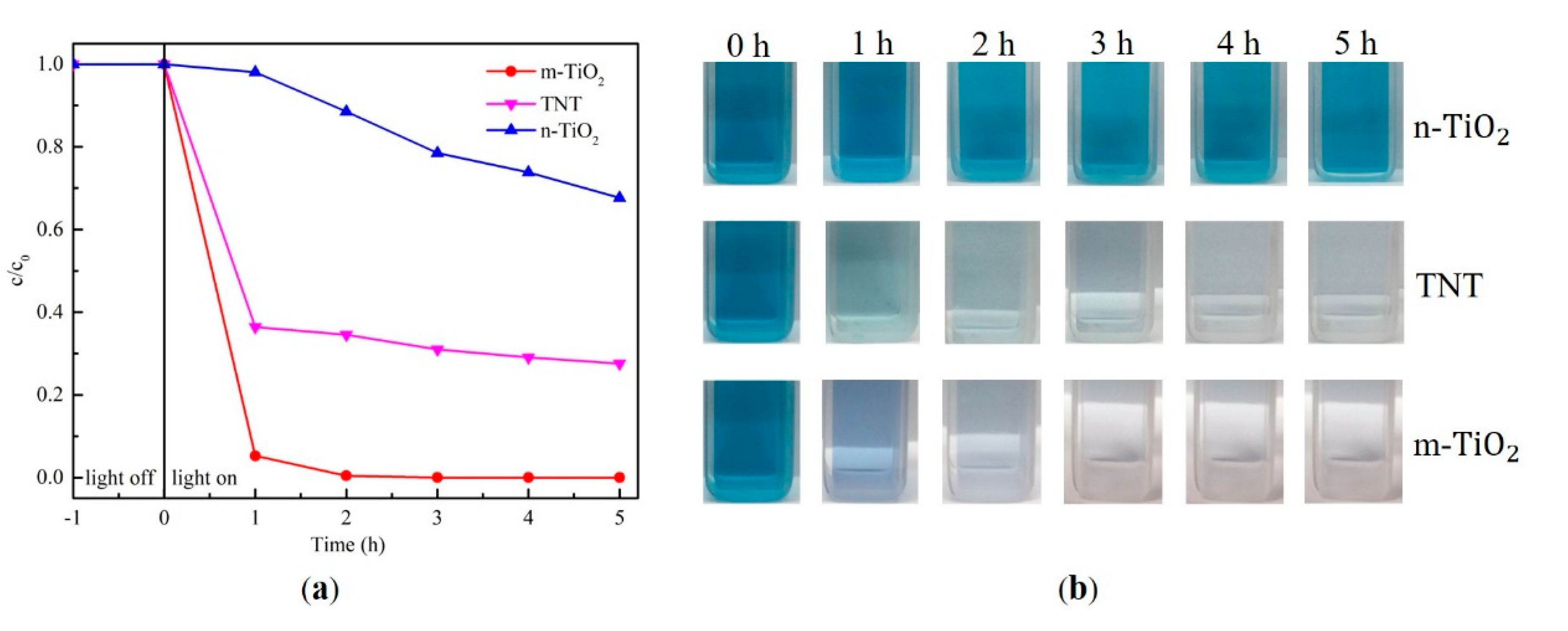
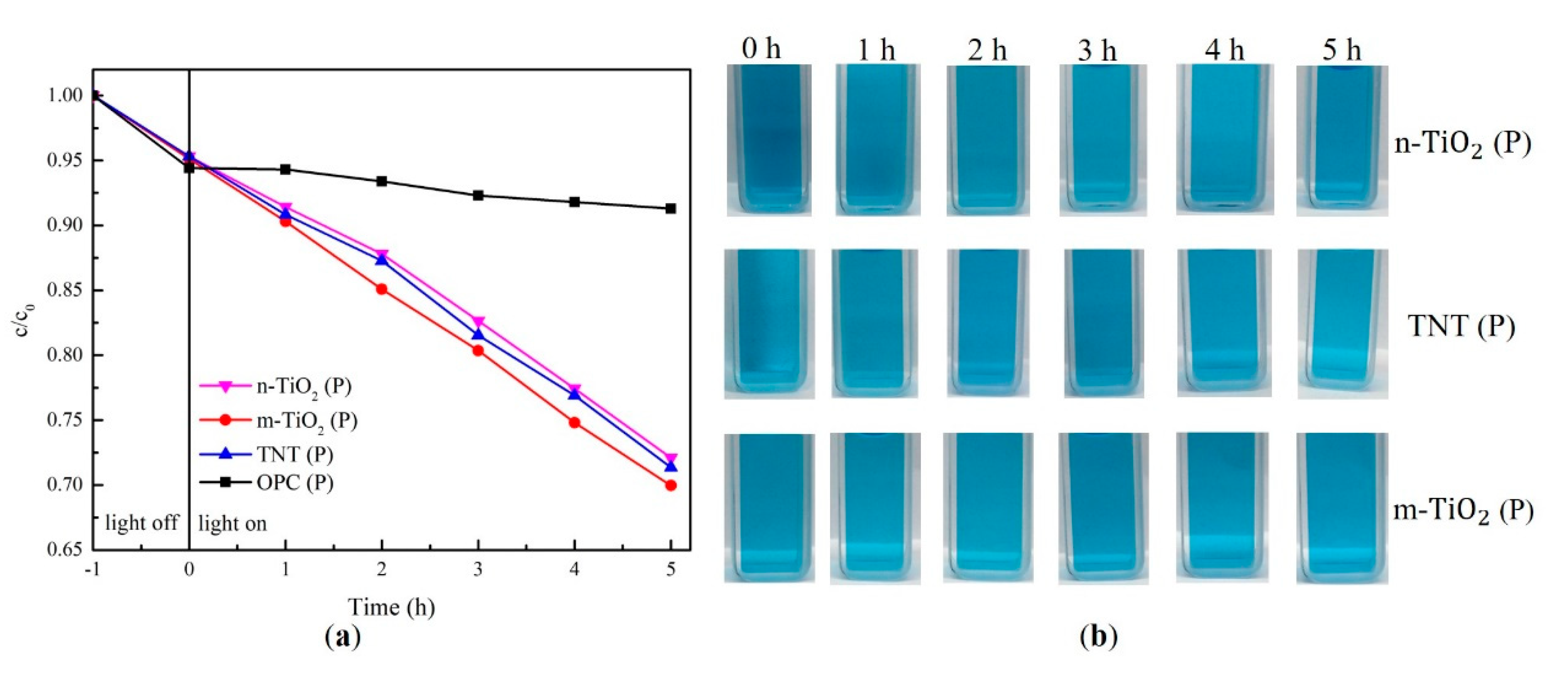
| SiO2 | Al2O3 | Fe2O3 | CaO | MgO | K2O | SO3 | TiO2 | LOI | Total |
|---|---|---|---|---|---|---|---|---|---|
| 18.43 | 2.83 | 2.17 | 68.17 | 2.37 | 1.11 | 3.03 | 0.15 | 1.72 | 100 |
| Name | Particle Size | Surface Area | Purity |
|---|---|---|---|
| m-TiO2 | 0.15–0.25 µm | 10.89 m2/g | 98.5% |
| n-TiO2 | <25 nm | 45–55 m2/g | 99.7% |
| Samples | m-TiO2 (g) | n-TiO2 (g) | TNT (g) | W/C | Water (g) | Cement (g) |
|---|---|---|---|---|---|---|
| OPC (P) | - | - | - | 0.4 | 16 | 40 |
| m-TiO2 (P) | 0.4 | - | - | |||
| n-TiO2 (P) | - | 0.4 | - | |||
| TNT (P) | - | - | 0.4 |
| Product | Outside Diameter | Inside Diameter | Average Length | Max Length | Min Length | Surface Area |
|---|---|---|---|---|---|---|
| TNT | 8 ± 3.4 nm | 3 ± 2.5 nm | 105 nm | 200 nm | 50 nm | 196 m2/g |
| Concentration of MB Solution (mg/mL) | ||||||
|---|---|---|---|---|---|---|
| 0 h | 1 h | 2 h | 3 h | 4 h | 5 h | |
| m-TiO2 | 1.51 | 0.02 | 0.00 | 0.00 | 0.00 | 0.00 |
| n-TiO2 | 1.51 | 1.32 | 1.18 | 1.13 | 1.05 | 0.97 |
| TNT | 1.51 | 0.51 | 0.5 | 0.45 | 0.43 | 0.40 |
| Concentration of MB Solution (mg/mL) | ||||||
|---|---|---|---|---|---|---|
| 0 h | 1 h | 2 h | 3 h | 4 h | 5 h | |
| OPC (P) | 1.41 | 1.41 | 1.39 | 1.38 | 1.37 | 1.36 |
| m-TiO2 (P) | 1.42 | 1.32 | 1.24 | 1.15 | 1.09 | 1.03 |
| n-TiO2 (P) | 1.42 | 1.39 | 1.33 | 1.25 | 1.17 | 1.08 |
| TNT (P) | 1.42 | 1.37 | 1.32 | 1.23 | 1.16 | 1.09 |
Publisher’s Note: MDPI stays neutral with regard to jurisdictional claims in published maps and institutional affiliations. |
© 2020 by the authors. Licensee MDPI, Basel, Switzerland. This article is an open access article distributed under the terms and conditions of the Creative Commons Attribution (CC BY) license (http://creativecommons.org/licenses/by/4.0/).
Share and Cite
Liu, J.; Jee, H.; Lim, M.; Kim, J.H.; Kwon, S.J.; Lee, K.M.; Zal Nezhad, E.; Bae, S. Photocatalytic Performance Evaluation of Titanium Dioxide Nanotube-Reinforced Cement Paste. Materials 2020, 13, 5423. https://doi.org/10.3390/ma13235423
Liu J, Jee H, Lim M, Kim JH, Kwon SJ, Lee KM, Zal Nezhad E, Bae S. Photocatalytic Performance Evaluation of Titanium Dioxide Nanotube-Reinforced Cement Paste. Materials. 2020; 13(23):5423. https://doi.org/10.3390/ma13235423
Chicago/Turabian StyleLiu, Junxing, Hyeonseok Jee, Myungkwan Lim, Joo Hyung Kim, Seung Jun Kwon, Kwang Myong Lee, Erfan Zal Nezhad, and Sungchul Bae. 2020. "Photocatalytic Performance Evaluation of Titanium Dioxide Nanotube-Reinforced Cement Paste" Materials 13, no. 23: 5423. https://doi.org/10.3390/ma13235423
APA StyleLiu, J., Jee, H., Lim, M., Kim, J. H., Kwon, S. J., Lee, K. M., Zal Nezhad, E., & Bae, S. (2020). Photocatalytic Performance Evaluation of Titanium Dioxide Nanotube-Reinforced Cement Paste. Materials, 13(23), 5423. https://doi.org/10.3390/ma13235423






